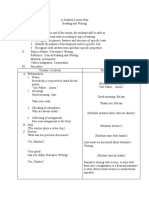0% found this document useful (0 votes)
42 views11 pagesDescriptive Writing Practice
Descriptive writing is a style that uses rich sensory details to create vivid imagery for the reader. Key elements include sensory details, figurative language, precise language, organized structure, and establishing mood and tone. Effective descriptive writing shows rather than tells, allowing readers to visualize the subject through actions and sensory experiences.
Uploaded by
mitraCopyright
© © All Rights Reserved
We take content rights seriously. If you suspect this is your content, claim it here.
Available Formats
Download as PDF, TXT or read online on Scribd
0% found this document useful (0 votes)
42 views11 pagesDescriptive Writing Practice
Descriptive writing is a style that uses rich sensory details to create vivid imagery for the reader. Key elements include sensory details, figurative language, precise language, organized structure, and establishing mood and tone. Effective descriptive writing shows rather than tells, allowing readers to visualize the subject through actions and sensory experiences.
Uploaded by
mitraCopyright
© © All Rights Reserved
We take content rights seriously. If you suspect this is your content, claim it here.
Available Formats
Download as PDF, TXT or read online on Scribd
/ 11




























































